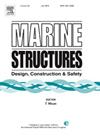波流联合激励下并排驳船三维间隙共振的CFD模拟
IF 5.1
2区 工程技术
Q1 ENGINEERING, CIVIL
引用次数: 0
摘要
利用基于Navier-Stokes方程的全非线性数值波槽,研究了两艘固定并排驳船在波浪和均匀电流联合激励下的三维间隙共振。它研究了与规则波对齐的电流如何影响头海和波束海下的间隙响应。在波束海中,海隙中的自由表面主要表现为驻波形式的模态响应。最大间隙响应始终出现在间隙的中点,随着当前速度的增加而逐渐增加。相反,在首海,随着流速的增加,最大响应略有减小,发生位置向下游移动。此外,沿头海间隙的共振自由面响应表现为传播波而不是模态型驻波,由共振波周围的波分量组成的频谱更宽,并且无论当前速度如何,其传播速度都比入射波快。这些共振波的波长随电流速度的增加而增加。此外,在横海条件下,水流的存在显著地增大了驳船的横向一次谐波力和平均漂波力。该研究强调了在沿海和近海作业中考虑电流对三维间隙共振影响的必要性。本文章由计算机程序翻译,如有差异,请以英文原文为准。
CFD modeling of three-dimensional gap resonances between side-by-side barges under combined wave and current excitation
The present study investigates three-dimensional gap resonance between two fixed side-by-side barges under combined wave and uniform current excitation using a fully nonlinear numerical wave tank based on the Navier–Stokes equations. It examines how currents aligned with regular waves affect the gap response under head and beam seas. In beam seas, the free surface in the gap primarily exhibits a modal-type response in the form of a standing wave. The maximum gap response, consistently occurring at the midpoint of the gap, increases gradually with the current speed. Conversely, in head seas, the maximum response decreases slightly with increasing current speed, and the occurring location shifts downstream. Moreover, resonant free-surface responses along the gap in head seas manifest as propagating waves rather than modal-type standing waves, consisting of a wider spectrum of wave components around the resonant ones and traveling faster than the incident waves regardless of current speed. The wavelengths of those resonant waves tend to increase with increasing current speed. Additionally, the presence of current significantly enlarges the transverse first-harmonic and mean-drift wave forces on the barges under beam-sea conditions. The study highlights the necessity of considering current effects on three-dimensional gap resonances in marine operations at coastal and offshore locations.
求助全文
通过发布文献求助,成功后即可免费获取论文全文。
去求助
来源期刊

Marine Structures
工程技术-工程:海洋
CiteScore
8.70
自引率
7.70%
发文量
157
审稿时长
6.4 months
期刊介绍:
This journal aims to provide a medium for presentation and discussion of the latest developments in research, design, fabrication and in-service experience relating to marine structures, i.e., all structures of steel, concrete, light alloy or composite construction having an interface with the sea, including ships, fixed and mobile offshore platforms, submarine and submersibles, pipelines, subsea systems for shallow and deep ocean operations and coastal structures such as piers.
 求助内容:
求助内容: 应助结果提醒方式:
应助结果提醒方式:


